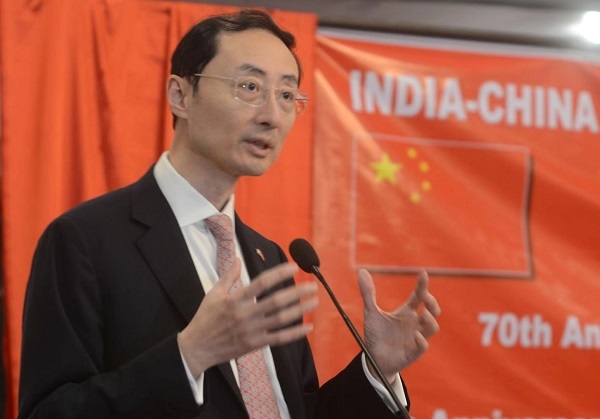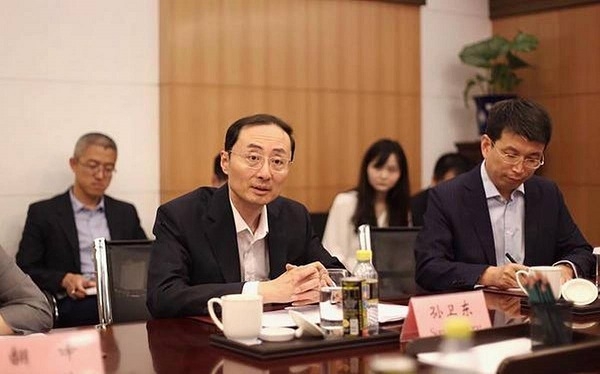Whom is Chinese Ambassador fooling?
Total Views |
Ambassador Sun Weidong latest statement, by diplomatic protocol and etiquette, that China and India “should meet each other halfway” to “overcome” the “complex situation” in ties and “turn it around as soon as possible” is admittedly laudable gesture to avoid unnecessary confrontation or disharmony with a view to restore peace and stability. Sun Weidong needs to realize that restoration of “Mutual Trust” is most difficult particularly after recent “Creeping Incrementalism and Extended Coercion” on the Line of Actual Control (LAC) by the Peoples Liberation Army (PLA). To rebuild trust after the loss of 20 soldiers is not going to be easy. “Trust begets Trust” and it cannot be one-sided. Surely, the past is a prism through which future developments can be predicted. If so, Doklam crisis in 2017 was the result of PLAs coercion particularly when Narendra Modi was hosting Xi Jinping at Ahmadabad with the intent to promote enduring strategic relations in a give and take spirit. Also, the 1962 war and the border aggressions of 1967, and 1987 and large number border incursions on annual basis.
So, there is no point in recalling the Five Principles of Peaceful Coexistence from the 1950s and Hindi-Chini Bhai Bhai slogan. Also, how India and China had jointly advocated independent foreign policies. Non-interference in internal policies is yet another fraud particularly after the revelations of funding to the Congress Party – RGF etc. If Sun Weidong wants to build enduring strategic partnership - instead of remaining “opponents or adversaries” - he must advise his boss, Xi Jinping, to break the endless impasse or deadlock during the Special Representatives talks, the Working Mechanism for Consultation & Coordination on India-China Border Affairs (WMCC) and also the Military Commanders level talks as part of the border working mechanism at various levels to resolve and settle the LAC/border disputes with utmost expedition.

Lack of understanding of the details of the international border and the LAC is real amongst the majority. Let me make an attempt to briefly highlight the key features of confusion over the Line of Control (LoC), LAC and the international boundary. One, the 1948 ceasefire line (CFL) was negotiated by the UN after the Kashmir War. Following the Shimla Agreement between the two countries in 1972, it was designated as the LoC in 1972. The LoC is delineated on a map signed by DGMOs of both armies and has the international sanctity of a legal agreement. Two, in contrast the LAC is only a concept – it is not agreed upon by the two countries, neither delineated on a map nor demarcated on the ground. Ipso facto, there were no surveyed maps in existence in 1947.
Three, the alignment of the LAC in the eastern sector is along the 1914 McMahon Line, and there are minor disputes about the positions on the ground as per the principle of the high Himalayan watershed. This pertains to India’s international boundary as well, but for certain areas such as Longju and Asaphila. To recount, the Shimla Agreement was not signed by the Chinese albeit Chinese observer was present. Even until 1962 War, there was no map showing clearly demarcation on the ground except of “one” centimeter wide line delineated on a quarter inch map with top half of the portion blank. However, the agreement recognized the water-shed principle.
Four, the line in the middle sector is the least controversial but for the precise alignment to be followed in the Barahoti plains. Five, there were no physical demarcations of border in the Western Sector. Aksai Chin in Ladakh province of the princely state of Jammu and Kashmir was not part of British India, although it was a part of the British Empire. What followed thereafter were two White Papers on Indian states published by Vallabhbhai Patel’s Ministry. The first, in July 1948, had two maps: one had no boundary shown in the western sector, only a partial color wash; the second one extended the color wash in yellow to the entire state of J&K, but mentioned “boundary undefined”. The second White Paper was published in February 1950 after India became a Republic, where the map again had boundaries which were undefined.
Six, in July 1954, Nehru issued a directive that “all our old maps dealing with this frontier should be carefully examined and, where necessary, withdrawn. New maps should be printed showing our Northern and North Eastern frontier without any reference to any ‘line’. This map, as is officially used till date, formed the basis of dealings with China, eventually leading to the 1962 War. Next, the mention of the LAC as a line is traced to the letter written by Zhou En Lai to Nehru in 1956 followed by 1959. In his letter, Zhou had stated that the LAC (disconnected series of points on a map that could be joined up in many ways) consisted of “the so-called McMahon Line in the east and the line up to which each side exercises actual control in the west described only in general terms on maps not to scale.”
After the 1962 War, the Chinese claimed they had withdrawn to 20 km behind the LAC of November 1959. Zhou clarified the LAC again after the war in another letter to Nehru: “To put it concretely, in the eastern sector it coincides in the main with the so-called McMahon Line, and in the western and middle sectors it coincides in the main with the traditional customary line which has consistently been pointed out by China”. Nehru unequivocally rejected the concept of LAC in both 1959 and 1962. However, following discussion in 1991, India formally accepted the concept of the LAC when P V Narasimha Rao paid a visit to Beijing in 1993 and the two sides signed the Agreement to Maintain Peace and Tranquility at the LAC. Most importantly, the agreement did not refer to the LAC of 1959 or 1962 but to the LAC at the time when the agreement was signed. To reconcile the differences about some areas, the two countries agreed that the Joint Working Group on the border issue would take up the task of clarifying the alignment of the LAC.

Sun Weidong needs to accept that the Chinese side is faulting over the issue of exchanging maps showing the delineation of the LAC whereas the Indian side had given maps showing the LAC version. Yet another significant even that needs recounting is the formal exchange of maps. India and China have ‘shared’ and exchanged maps for the middle sector only. Maps were “shared” for the western sector but never formally exchanged, and the process of clarifying the LAC has effectively stalled since 2002. It is also relevant to note that there is no publicly available map depicting India’s version of the LAC in the Western theater. During his visit to China in May 2015, PM Narendra Modi’s proposal to clarify the LAC was rejected by the Chinese. Deputy Director General of the Asian Affairs at the Foreign Ministry, Huang Xilian later told Indian journalists that “We tried to clarify some years ago but it encountered some difficulties, which led to even complex situation. That is why whatever we do we should make it more conducive to peace and tranquility for making things easier and not to make them complicated.”
In sum, the extraordinary nature of complexity of border disputes is real: “China and India have the boundary question left over by history, which is sensitive and complicated.” India wants a fair and reasonable solution mutually acceptable "through equal consultation and peaceful negotiation". Just as Sun Weidong affirms that pending an ultimate settlement, we both agree to work together to maintain peace and tranquility in the border areas, and peace was of paramount importance to China, so also it is for India. Sun Weidong is absolutely correct in highlighting that for building “mutual trust”, each side “need to respect and accommodate mutual core interests and major concerns”, and “adhere to the principle of non-interference in each other’s internal affairs”.
Great diplomatic sermon by Sun Weidong! Sun Weidong must introspect and amplify what he means by “shared interests”? Is it Peace and tranquility on the borders and in the South Asian region? Or, is it shared interests with Pakistan contrary to India’s national security interests? China’s shared interests with Pakistan are contra shared Indian interests. To remind Sun Weidong let me recall statement by Hu Jintao’s, former China’s President” about Pakistan as “Higher than the mountains and Deeper than the Oceans”. Also, Xi Jinping stated “good friends, good partners and good brothers”. Two days before his meeting with Modi, he had stated that “China will continue to firmly support Pakistan’s core interests and key concerns that include Kashmir issue, Masood Azhar etc – all weather strategic cooperation – unbreakable and rock solid.”
Earlier Sun Weidong realizes that Pakistan is hell bent upon seeking revenge against India by 1000-year Jihad, the better it is for him. Is he blind to the fact of “proxy war” conducted through the ISI and non-state actors over the past 30-years by Pakistan? Furthermore, following China’s aggressive forays in South China Sea, East China Sea, Taiwan, Japan and others, there are few takers in India to accept his statement that “China is neither a warlike state nor an assertive country”. How can Sun Weidong justify the PLA deploying the forces of Western Theater Command forces from neighboring Xinjiang Military District and 77 Army Group formations on the LAC? Yes – Ambassador Su Weidong, following the de-escalation and disengagement of troops from LAC, the next step is de-induction of troops from Tibet. Then only, there can be meaningful scope for timely strategic dialogue, enhance mutual trust and to shun suspicion and friction in bilateral ties.
Be that as it may, Sun Weidong has conveyed a veiled threat against the “unfair” boycott of Chinese products by India. “Some people have been trumpeting the so-called ‘decoupling’ of China-India economic and trade relations, with an attempt to completely exclude ‘Made in China’. “Any self-protection, non-tariff barriers and restrictive measures against China are unfair to Chinese enterprises, unfair to Indian employees who lost their jobs as a result, and unfair to Indian consumers who cannot get access to the products and services they deserve. It will only harm others without benefit to oneself, and it will eventually hurt oneself as well,” he said. In sum, Sun Weidong genuinely wants to “bring bilateral relations back on the right track”, China must fulfill 2 conditions: conclude border demarcation and sign a treaty; and delink its strategic partnership/alliance with Pakistan – it’s all weather partner.
Otherwise, the scope for India and China meeting each other "half way" at a time they were faced with a complex situation may remain a mirage. And, his prescription that the two countries should be partners and not rivals may remain forlorn hope. Sun Weidong also need not indulge in veiled threats on economic and trade fronts: "self-protection, non-tariff barriers and restrictive measures" against China are unfair to Chinese enterprises, benefits of global supply chains and also to Indian employees who lose their jobs as a result, and Indian consumers. India of 2020 is no more India of 1962.


